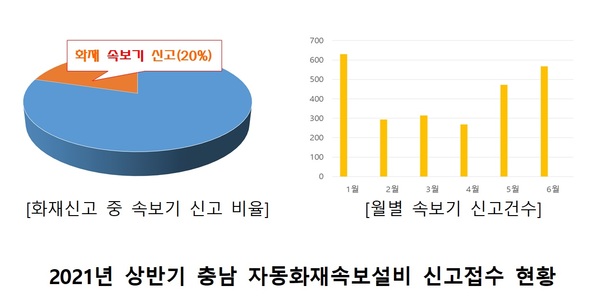In the first half of the year, Chungcheongnam-do made more than 2,500 futile attempts... Promoting special measures

[Reporter Choi Shin-woong, Geumgang Ilbo] It was found that the administrative power of South Chungcheong firefighters working to ensure the safety of residents was being wasted due to malfunctioning fire detectors. Accordingly, the fire department is taking special measures to reduce fire detector malfunctions.
According to the provincial fire headquarters on the 3rd, there were a total of 2,546 fire reports received through fire detectors (automatic fire warning equipment) in the first half of this year. This amounts to 20.1% of the total 12,641 fire reports in the first half of the year. The problem is that out of 2,546 cases, there were only 11 cases, or 0.4%, in which damage was prevented by the fire brigade that responded to an actual fire. In the end, 99.6% of the time, there was no actual fire, but the fire detector reported that there was a fire, so the fire truck was dispatched in vain.
The automated fire warning system is a system that detects fire situations and automatically reports them to 119, and is linked to the automatic fire detection system. To detect a fire situation, it consists of a heat detector that detects heat accumulation above a certain temperature and a smoke detector that detects smoke above a certain concentration.
The main causes of malfunction are electrical factors such as heat, moisture, dust, etc. in confined spaces with poor ventilation. In particular, reports of malfunctions are concentrated in the winter, when accumulated snow melts and moisture can easily seep in, and in the summer after June when the temperature and humidity are high. In fact, this year, the largest number of reports were received in January, and after a decline in the dry spring, the number is showing an upward trend again in June.
The provincial fire headquarters will form a task force jointly with 16 fire stations in the province to pursue comprehensive and fundamental improvements by the end of the year. The plan is to provide training and necessary information to personnel at 1,632 locations such as factories and buildings where automated fire warning equipment is installed, as well as to find fundamental solutions through cause analysis for subjects where malfunctions frequently occur.
In addition, we plan to respond organically to produce practical results by analyzing and feedbacking the effectiveness of each month's performance. In addition, we plan to analyze the actual status of fire detector malfunctions and actively reflect this in preventive measures such as applying firefighting facilities when constructing new buildings or changing use in the future.
Song Won-seok, head of the situation analysis team at the 119 General Situation Room, said, “Through TF operation, we will reduce unnecessary fire truck dispatches and allow crews to focus on the disaster scene. We ask for active interest and cooperation from those involved to ensure stable fire safety management.” said.
Naepo = Reporter Choi Shin-woong csu@ggilbo.com
